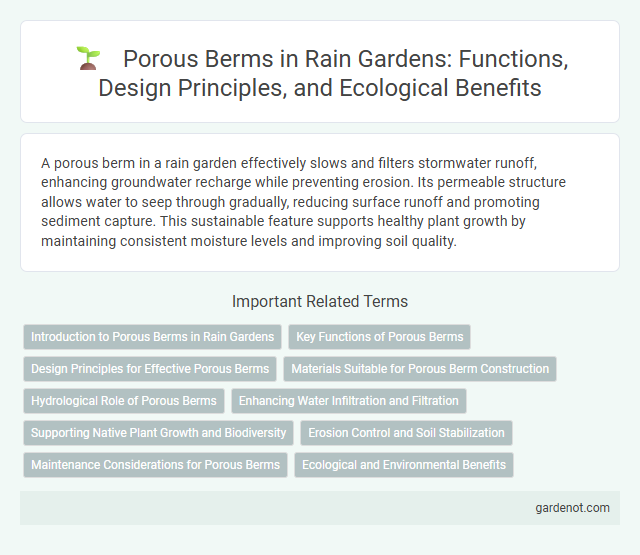A porous berm in a rain garden effectively slows and filters stormwater runoff, enhancing groundwater recharge while preventing erosion. Its permeable structure allows water to seep through gradually, reducing surface runoff and promoting sediment capture. This sustainable feature supports healthy plant growth by maintaining consistent moisture levels and improving soil quality.
Introduction to Porous Berms in Rain Gardens
Porous berms in rain gardens function as permeable barriers designed to slow down and infiltrate stormwater runoff, enhancing groundwater recharge and reducing surface erosion. Constructed using materials like gravel, sand, and compost, these berms promote water absorption while filtering pollutants before water reaches nearby ecosystems. Effective porous berm design includes appropriate sizing and vegetation to maximize water retention and improve overall rain garden performance.
Key Functions of Porous Berms
Porous berms play a crucial role in rain gardens by slowing stormwater runoff and promoting infiltration into the soil, which reduces erosion and surface water flow. They act as a natural barrier that filters pollutants and sediments, improving water quality before it reaches groundwater or drainage systems. By maintaining moisture balance and supporting vegetation health, porous berms enhance the overall effectiveness and sustainability of rain garden ecosystems.
Design Principles for Effective Porous Berms
Design principles for effective porous berms emphasize proper sizing to ensure adequate infiltration capacity and prevent overflow, typically based on local rainfall data and soil permeability rates. The berm should be constructed with a mix of permeable materials such as gravel and sand to facilitate water absorption while maintaining structural stability. Strategic placement along contour lines maximizes water retention, reduces runoff velocity, and enhances sediment capture, contributing to the overall functionality of rain gardens.
Materials Suitable for Porous Berm Construction
Materials suitable for porous berm construction include crushed stone, gravel, and recycled concrete, all of which provide excellent permeability and structural support. Incorporating geotextile fabric beneath the berm helps prevent soil migration while maintaining water infiltration. Selecting durable, non-toxic materials ensures long-term functionality and promotes effective stormwater management in rain garden systems.
Hydrological Role of Porous Berms
Porous berms play a critical hydrological role in rain gardens by slowing runoff and enhancing infiltration, which reduces surface erosion and promotes groundwater recharge. These structures trap sediments and pollutants, improving water quality before it percolates into the soil. By managing stormwater flow, porous berms support sustainable urban drainage and mitigate flooding risks.
Enhancing Water Infiltration and Filtration
Porous berms in rain gardens significantly enhance water infiltration by allowing stormwater to pass through their permeable structure, reducing surface runoff and promoting groundwater recharge. These berms act as natural filters by trapping sediments and pollutants, improving the quality of water entering the soil. Integrating porous berms with native vegetation further boosts filtration efficiency and supports sustainable stormwater management.
Supporting Native Plant Growth and Biodiversity
Porous berms in rain gardens enhance water infiltration and provide ideal moisture conditions for native plant roots, promoting robust growth and resilience. By creating microhabitats with varied soil moisture levels, porous berms support diverse plant species, increasing local biodiversity. These structures also help filter pollutants and reduce runoff, contributing to healthier ecosystems and sustainable urban landscaping.
Erosion Control and Soil Stabilization
Porous berms in rain gardens effectively enhance erosion control by slowing runoff and promoting water infiltration, which stabilizes soil structure. Constructed from permeable materials like gravel or compost, these berms reduce soil displacement and prevent sediment from washing away during heavy storms. Their design supports vegetation growth that further anchors the soil, maintaining the integrity of the rain garden landscape.
Maintenance Considerations for Porous Berms
Maintaining porous berms requires regular inspection to ensure permeability and prevent clogging from sediment and debris accumulation. Periodic removal of accumulated materials and re-establishing vegetation helps sustain water infiltration and erosion control. Proper maintenance extends the berm's functionality in managing stormwater runoff within rain gardens.
Ecological and Environmental Benefits
Porous berms enhance rain garden performance by effectively managing stormwater runoff through natural infiltration, reducing soil erosion and surface runoff. Their design supports groundwater recharge while filtering pollutants, improving water quality and contributing to healthier local ecosystems. These structures also create habitats for beneficial microorganisms and plants, boosting biodiversity and promoting ecological resilience.
Porous berm Infographic

 gardenot.com
gardenot.com